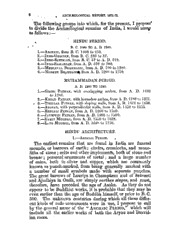
ARCHAEOLOGICAL REPORT PDF
Preview ARCHAEOLOGICAL REPORT
Anchasoleticad pabest 7 Ubrarten sertshas Public Libraré Bhadeh Moke. jce! Cottecttes ARCHEOLOGICAL REPORT, ‘REPORT OF OPERATION OF THE ARCH ROLOGICAL SURVEY. OF INDIA FOR THE SEASON 1871-73, Ix treating of Indian Antiquities, it would be a geest cou venience if we could make some tomy acrangemept of tyes or porinds that would divide our daily increasing materials into small and manageable groups, to which refer- ence could he made-as fo slinilatitics and differences of trentment, without committing oursclves to any system or thoory which we might afterwards have to shandon. Bat at present our knowledge of the Archmologiesl remaing of Tniiin is ino limited to enable ue to draw hard and fast lines “sen the diffurent etyles of building, or fo determina the Mt which these may have been adopted by any parti- ‘les or races, Tt appears to mo, therefore, more ~rangomont to divido our present, materials, as fae into a few distinetly marked chronological groups afterwards be redistributed, when our increased e matared Imowledge shall have provided ue with _2esenry amount of information for a more minnie and Seppropriate nomenclature, ARE huld thorofore, dive all the remains aé provent Inaown "fio a number of ditnet and broadly sumed Crone ~"ections, which would serve to isiinetecslaarly.. the saoh poe, ehila the wile wpe eee i} connected series Mustaine 2 grent advantage af a nt is ite ‘aalety, as it di ate y while it soem to indicate ‘particular style belongs: 2 > ARCHEOLOGICAL REPORT, 1971-73. “he following groups into which, for the presont, 1 proposct to divide the Arcklogia! emaizs of India, woald mam as follows ; . IEINDU PERION. : 3. ©, 1000 TO A.D, 3200, 1.=-Ancuare, from B.C. 1400 to 350. 2'—Txno-nzctan, from B.C. 250 to 87, 8.—Txpo-Scerman, fom B. G57 to A, D. 310, —Tyv0-Bassantan, from A.D. 319 to 700. —=Mavinvat, Brahscasie, from A. Dh 700 10 1200. -—Moveew Basatasigs from A.D. 2200 (y 1750, MUWAMMADAN PERIOD. AD. 1208-70 1750, L.—Guors Parmar, with overlapping arches, from A.D. 110 fo 1289. Kuru Pansan, with horseshoe urches, from A.D. 1259 tn 132 —Temtuas Prtea, with sloping walls, from A, D. 182) to 140, —Arenax, with perpendicular walls, trom A. D. 1450 to 1553 ‘—Busestt Parsax, from A, D. 1200 to 1.100. —Javsrugr Parnas, from A, D. 1100 te 1508, To-Eaare Mouuat, from A.D. 1556 to 128, 8. —Live Muon, fom A.D, 1638 to 1759, 2. HINDU ARCHITECTURE. LAgcoue Penior ‘The earliest remains that arc found in India ore funeral mounds, or barrows of carth; circles, cromlechs, and mono- liths of stone ; celts and other implementy, both of stone ma dronte ; personal ornaments of metal; and a luge number of coins, both in silver autl copper, which are comnionl; known as puuch-marked, from boing generally marked with a number of small esmbols made with separate pwsches, The great barrows of Lauriya in Champizan und of Srivasti and Ajudhiya in Oudb, are ‘simply earthen stupas, and must, therefore, have preceded the age of Asoka. As they do not appear to be Buddhist works, it ig probable that they may be even carlier than the age of Buddha himself, or prior ta B.C. 500. The unknown centuries during which all theso differ ont kinds of rude monuments were in use, I propose to call Dy tho generat name of the “ Ancnaze Peston,” which will include all the earlier works of both the Aryan aud Dre jon races, HINDU ARCHIFECTURD. to’. + To the Aryans bolong the stone walls of old Rijagrihe or Kusigarepura, the capityl of Bimbisdra,‘as well ae the Je: sindha-ka-Baithak and the Baibhar and Sonbhandir cares, all of which date certainly as early ag B.C.600. Tho Anonare Parton I wovld close at 250 B. C., when the rude workmen of India were firt Drought into close contact with tuo artists of Grecae, by the establishment of an independ- ent Grock monarehy in the Kabul valley, From this time tho native money of North-Western Indi borrows many of its designs from the comage of the Grecks, while its archi. tecture and militery system, its chronology and its astronomy, all show very strong traces of Greekffnflience. 2. uo-Gurcian Preron, The socond stage, which I would call the Ixno.Gnzcran Penson,” comprises most of the finest examples of Indian art, which belong almost exclusively to the age of Asoka, whose lion-pillays, with their bands of boney-suckle and bended mouldings, if nat the work of Greck ‘artists, show very able imitations of Greek design. ‘To this peviod belong tho Great Sinpas of Sfinchi and Sutdhire near Bhilsa, tho Buddhisi railings or colonnades of SAnchi and Gaya, and most probably ‘also the bas-eliefe of the Orissa caves. As the first Indo-Scythians or Sac adopted tho Grecian gods on their coinage, it seems probable that they effected ttle, if any, change in,the religion and arts of Northera India. But ‘With the accession of the lator Indo-Seythions, or *TYochavi, the Crock mythology wes at first saperseded by the Pasian worship of-the eleitents, and soon after by Indian Buddhism, whieh was zealously adopted by Kanishks. This chaage of xeligion, which certainly took place some time in the middle of the dst eanturyefore Christ, closes tho Greek period, which thus lasted for about two centuries, or from 330 ta 67 B.C. —Inno-Sevraray Prniop. ‘To the third, or Ixpo-Sormay, period belong most of the Buddhist and Jain senlptures and pillars which havo been exhumed from the mounds of Mathtra and from the ruined cities in the Yusufzai district, To this poriod also belong the earliest of tho Buddhist caves of Westem India executed by the Saka Prince Nahapina. ‘The infinenee of the Greok att of the preceding period is most strougly marked in the
